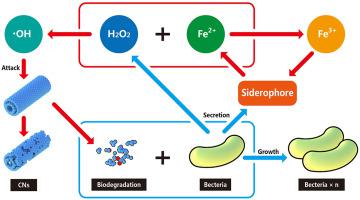Chemosphere ( IF 8.1 ) Pub Date : 2021-02-09 , DOI: 10.1016/j.chemosphere.2021.129888 Jingwei Wang , Shuang Shan , Qiao Ma , Zhaojing Zhang , Hongsheng Dong , Shuzhen Li , Catherine Sekyerebea Diko , Yuanyuan Qu

|
Carbon nanotubes (CNTs) have been widely studied because of their potential applications. The increasing applications of CNTs and less known of their environmental fates rise concerns about their safety. In this study, the biotransformation of multi-walled carbon nanotubes (MWCNTs) by Labrys sp. WJW was investigated. Within 16 days, qPCR analysis showed that cell numbers increased 4.92 ± 0.36 folds using 100 mg/L MWCNTs as the sole carbon source. The biotransformation of MWCNTs, which led to morphology and functional group change, was evidenced by transmission electron microscopy and X-ray photoelectron spectroscopy analyses. Raman spectra illustrated that more defects and disordered carbon appeared on MWCNTs during incubation. The underlying biotransformation mechanism of MWCNTs through an extracellular bacterial Fenton-like reaction was demonstrated. In this bacteria-mediated reaction, the  OH production was induced by reduction of H2O2 involved a continuous cycle of Fe(II)/Fe(III). Bacterial biotransformation of MWCNTs will provide new insights into the understanding of CNTs bioremediation processes.
OH production was induced by reduction of H2O2 involved a continuous cycle of Fe(II)/Fe(III). Bacterial biotransformation of MWCNTs will provide new insights into the understanding of CNTs bioremediation processes.
中文翻译:

类芬顿反应驱动细菌介导的多壁碳纳米管的降解和吸收
碳纳米管(CNTs)由于其潜在的应用而被广泛研究。碳纳米管的应用不断增加,其环境命运鲜为人知,这引起了人们对其安全性的担忧。在这项研究中,Labrys对多壁碳纳米管(MWCNT)的生物转化sp。WJW进行了调查。在16天之内,qPCR分析表明,使用100 mg / L MWCNTs作为唯一碳源,细胞数增加了4.92±0.36倍。透射电镜和X射线光电子能谱分析证明了MWCNTs的生物转化,导致其形态和官能团的变化。拉曼光谱表明,在孵育过程中,MWCNT上出现了更多的缺陷和无序碳。MWCNTs通过细胞外细菌Fenton样反应的潜在生物转化机制得到了证明。在该细菌介导的反应中, 通过减少H 2 O 2诱导了OH的产生。涉及Fe(II)/ Fe(III)的连续循环。MWCNTs的细菌生物转化将为了解CNTs生物修复过程提供新的见解。
通过减少H 2 O 2诱导了OH的产生。涉及Fe(II)/ Fe(III)的连续循环。MWCNTs的细菌生物转化将为了解CNTs生物修复过程提供新的见解。











































 京公网安备 11010802027423号
京公网安备 11010802027423号